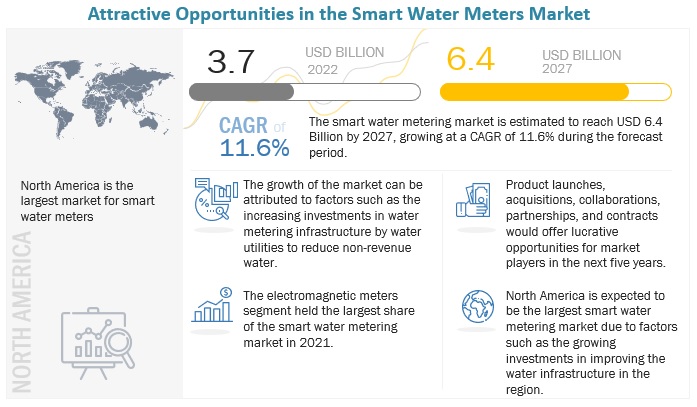According to a research report “Smart Water Metering Market by Meter type (Ultrasonic, Electromagnetic, Smart Mechanical), Application (Water Utilities, Industries), Technology (AMI, AMR), Component (Meter & Accessories, Communications) and Region – Global Forecast to 2027″ published by MarketsandMarkets, the Smart Water Metering market is expected to grow at a CAGR of 11.6% during the forecast period, from an estimated USD 3.7 billion in 2022 to USD 6.4 billion in 2027. The rising urban population is creating opportunities for the development of smart cities, which ultimately is driving the demand for smart water metering infrastructure development on a larger scale.
Download PDF Brochure: https://www.marketsandmarkets.com/requestsampleNew.asp?id=250996975
The water utilities segment, by application, is expected to be the most significant smart water metering segment during the forecast period.
The water utilities segment accounts for the largest share of the global smart water metering market. The water grid used for the distribution of water is a key part of water utilities infrastructure. Currently, water utilities are concerned about leakage detection and prevention, which results in large volumes of water loss. Significant developments in smart metering infrastructure is driving the market growth.

AMR is anticipated to be the fastest-growing smart water metering segment, by technology, during the forecast period.
AMR is a system and process used to remotely collect water meter data without the physical presence of personnel at the reading point. AMR is a key driver of proficiency for water utilities by lowering operational costs by optimizing maintenance and reducing human intervention in the measurement operation. An effective AMR system can only work if the water meter has a connectivity point such as a pulse out where a radio transmitter will be attached to it. North America and Europe are the regions mostly implementing this technology. Other regions have also started implementing this metering infrastructure to reduce non-revenue water.
Asia Pacific is expected to be the fastest-growing segment in the global smart water metering market, by region, during the forecast period.
In this report, the smart water metering market has been analyzed for five regions, namely, Asia Pacific, North America, Europe, Middle East & Africa, and South America. Asia Pacific is expected to lead the market during the forecast period.
According to the World Water Council, 12.5% of Asia Pacific’s population does not have access to safe drinking water. The UN’s 2030 Agenda for Sustainable Development involves the mission to provide access to safe drinking water and sanitation rights. South Asian countries are already investing to achieve these goals. On the other hand, underdeveloped countries still lack basic water infrastructure, which is hampering the growth of the Asia Pacific smart water metering market.
Countries such as China, Australia, Singapore, and India are developing smart infrastructure for water consumption and water supply. For instance, Singapore’s national water agency, PUB, announced the installation of 300,000 smart water meters in the nation by 2030. Such initiatives are offering lucrative opportunities for suppliers to expand their regional reach in the Asia Pacific.
Ask Sample Pages: https://www.marketsandmarkets.com/pdfdownloadNew.asp?id=250996975
To enable an in-depth understanding of the competitive landscape, the report includes the profiles of some of the top players in the smart water metering market. These include BADGER METER, INC. (US), Sensus (US), Diehl Stiftung & Co. KG (Germany), Aclara Technologies (US), and Itron, Inc. (US). The leading players are trying to establish themselves in the markets of developed countries and are adopting various strategies to increase their respective market shares.


